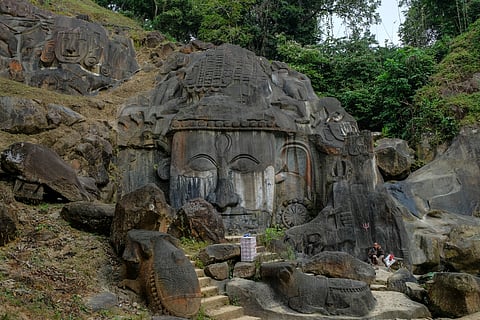
- Destinations
- Experiences
- Stay
- What's new
- Editor’s Picks
- Responsible Tourism
- CampaignsCampaigns
- Subscribe

Known as the "Angkor Wat of the North-East," Tripura's Unakoti will soon have amenities like toilets, clean drinking water, and accommodations for travellers. The gorgeous region famous for its centuries-old Shaivite rock sculptures and hill faces has been shortlisted as a UNESCO World Heritage Site. The Department of Tourism has now directed the Archeological Survey of India (ASI) to establish a cafeteria in the region and other infrastructural facilities for tourists.
The ASI safeguards the 8th-9th century rock carvings on Raghunandan hills, about 180 km from Agartala, which presently has some very basic amenities. With an infusion of funds, the tourism department is working progressively on infrastructural advancements around the Unakoti archaeological site. A substantial grant of Rs 70 crore from the Union Ministry of Culture, coupled with an anticipated Rs 70 crore loan from the Asian Development Bank (ADB), signifies the growth of tourism-related infrastructure.
Additionally, a contemporary lodging facility is in the works at Sonamukhi Tea Estate, approximately 7-8 km from the Unakoti site. According to officials, there will be accommodation facilities to fit at least 32 families, along with a swimming pool and adventure sports facilities. There will also be a meditation centre and a parking lot for visitors.
Embarking on a journey around 180 km from Agartala, one arrives at the district of Unakoti, where an ancient stone gateway ushers you into a realm adorned with monumental stone and rock sculptures hewn into the hillside.
Meandering bridges and timeworn staircases traverse the terrain, guiding the way to Unakotiswara Kal Bhairava, a towering 30-feet Shiva's head, flanked by goddess sculptures—Ganga perched atop a Capricorn and Durga poised on a lion. Meticulously sculpted figures of Hindu deities like Hanuman and Ganesha breathe life into this timeless panorama of religious artistry. Nestled within the lush depths of Jampui Hills, this treasure trove of India's heritage remains a known yet overshadowed gem, aptly dubbed the "Lost Hill of Faces."
There are many legends surrounding the place and how it came to be. One of the more famous ones involves the wrath of Lord Shiva. One important thing to know is the origin of the name Unakoti. The word Unakoti means "one less than a crore," and according to folklore, the hills of Unakoti have 99,99,999 rock-cut images of Gods and Goddesses.
In ancient times, Lord Shiva embarked on a journey with many Gods and Goddesses towards Kashi, the timeless city of illumination. Their count stood at a staggering ten million or one crore. Along their path, Lord Shiva paused their expedition for the night on the Raghunandan Hills. Yet, before retiring, he instructed the remaining 99,99,999 deities to rise and prepare themselves before the break of dawn, considering the distance they still had to traverse to reach Kashi.
When the next day's light broke, it revealed a scene contrary to Lord Shiva's directiveall—, except Shiva himself, were deep in sleep. Taking in the scene in front of him, Lord Shiva's wrath ignited, and he cast a curse upon the other Gods and Goddesses, transforming them into stones. This legendary tale narrates the origin of the stone depictions of "una-koti" or just short of one crore deities adorning the slopes of the Unakoti Hills.
Once, Unakoti thrived as a revered centre of worship. Streams meandered by the foothills, the fragrance of incense lingered in the air, and multitudes of devotees congregated for spiritual homage. The site flourished as a Shaivite pilgrimage destination from the 8th or 9th century CE until its eventual decline in modern times. Masterful artisans infused local legends into the stone sculptures, evoking past stories. A sole vestige of its past significance, the annual Ashokastami Mela, held every April, serves as a poignant reminder of its former eminence.
Getting There: The nearest railhead is Kumarghat, which is well-connected to all nearby cities. The nearest major airport is Agartala, which is nearly three-and-a-half hours away.
(With inputs from PTI)
